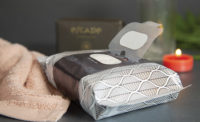Microsphere Adhesives Open a World of Possibilities
Microsphere adhesives limit physical contact by forming a discontinuous adhesive surface.

Peel and re-stick. Peel and re-stick. The number of times a label or other product coated with a microsphere adhesive can be re-applied seems as endless as the possible applications for this product-the most repositionable pressure-sensitive adhesive (PSA) developed to date. Microsphere adhesive technology was developed in 1968 and subsequently appeared as the glue strip on the back of repositionable notepaper. Recently, Franklin Adhesives & Polymers developed its own microsphere technology and introduced Micronax®, a new line of microsphere adhesives.
The Micronax brand of microsphere adhesives expands the versatility of microsphere adhesives, offering formulations for use in a host of applications well beyond sticky notes. Micronax takes the basic formulation for microspheres to the next level, in part by varying the sizes of the particles-or spheres-that render microsphere adhesives so repositionable.
By forming a discontinuous adhesive surface, microsphere adhesives limit physical contact. This results in low peel and stable tack over time. The microsphere adhesive holds products firmly in place on most substrates, but it is easily removable and permanently repositionable. Conversely, emulsion adhesives use smaller particles that coalesce into a continuous film that is not repositionable. Their larger particle size imparts the power of repositionability to microsphere adhesives, giving coaters and product manufacturers a versatile adhesive for use in countless applications.

A number of performance characteristics increase the versatility of the new adhesives. For example, they are resistant to ultraviolet rays, which makes them ideal for products that are likely to be exposed to the sun. They can be screen-printed at no risk to their long-term performance, and they have gained U.S. Food and Drug Administration (FDA) approval for indirect food contact so they can be used on food-packaging applications. They also can be printed, die-cut and transfer coated. In addition, they are acid-free, which eliminates the risk of damage to substrates, such as photos, over the long term.
Micronax microsphere adhesives also offer the ability to customize sphere sizes, from 20-80 microns, for varying degrees of tack. All Micronax microspheres are easily repositionable, but they vary in viscosity; percentage of solids; pH value; shelf life; and tack, peel, and shear. Existing and custom formulations can easily meet varying requirements for applications that require a highly repositionable PSA.
Any item that needs to be removed and reapplied to virtually any substrate (but that needs to adhere well over time) is a candidate for this adhesive technology. Topping the list of potential applications are product decorations, wall graphics, temporary signage and repositionable notes. Microsphere adhesives could be used to develop effective, attention-getting advertising pieces, and they also have potential in the arts and crafts arena. These microspheres are proven to work well in laminators, dispensers, glue dots, glue sticks, wet glues, glue pens, tapes, adhesive sheets, and other products for gluing substrates in the creation of just about any handcrafted work of art.
Microspheres also satisfy the appetite for easy sealing in the food packaging industry. A strip of the adhesive can make it easy to open and close bags of cookies, bread, and other consumables that need to remain fresh in their original containers.
For more information, call (800) 877-4583, e-mail marketing@franklininternational.com or visit www.franklinadhesivesandpolymers.com.

Peel and re-stick. Peel and re-stick. The number of times a label or other product coated with a microsphere adhesive can be re-applied seems as endless as the possible applications for this product-the most repositionable pressure-sensitive adhesive (PSA) developed to date. Microsphere adhesive technology was developed in 1968 and subsequently appeared as the glue strip on the back of repositionable notepaper. Recently, Franklin Adhesives & Polymers developed its own microsphere technology and introduced Micronax®, a new line of microsphere adhesives.
The Micronax brand of microsphere adhesives expands the versatility of microsphere adhesives, offering formulations for use in a host of applications well beyond sticky notes. Micronax takes the basic formulation for microspheres to the next level, in part by varying the sizes of the particles-or spheres-that render microsphere adhesives so repositionable.
Larger Spheres
Microsphere adhesives offer advanced performance characteristics, yet their repositionability is based on a simple concept: particle size. Microspheres are tiny particles that measure between 10 and 250 microns in diameter. Although they are microscopic in size, these spheres are still much larger than the emulsion particles found in conventional adhesives. The size difference between the particles has a dramatic impact on adhesive tack.By forming a discontinuous adhesive surface, microsphere adhesives limit physical contact. This results in low peel and stable tack over time. The microsphere adhesive holds products firmly in place on most substrates, but it is easily removable and permanently repositionable. Conversely, emulsion adhesives use smaller particles that coalesce into a continuous film that is not repositionable. Their larger particle size imparts the power of repositionability to microsphere adhesives, giving coaters and product manufacturers a versatile adhesive for use in countless applications.

Microsphere adhesives hold products firmly in place on most substrates, but are easily removable and permanently repositionable.
Multiple Uses
The high repositionability of microspheres, coupled with the increased versatility offered through the new Micronax formulation, opens up new possibilities for use of this PSA. The microspheres adhere very well to a variety of common substrates, including paper, cardboard, films, wood and ceramic. What’s more, they adhere to additional substrates that typically require special adhesive formulations, such as metal, painted surfaces, tinted windows, refrigerators, walls, cabinets and photos.A number of performance characteristics increase the versatility of the new adhesives. For example, they are resistant to ultraviolet rays, which makes them ideal for products that are likely to be exposed to the sun. They can be screen-printed at no risk to their long-term performance, and they have gained U.S. Food and Drug Administration (FDA) approval for indirect food contact so they can be used on food-packaging applications. They also can be printed, die-cut and transfer coated. In addition, they are acid-free, which eliminates the risk of damage to substrates, such as photos, over the long term.
Micronax microsphere adhesives also offer the ability to customize sphere sizes, from 20-80 microns, for varying degrees of tack. All Micronax microspheres are easily repositionable, but they vary in viscosity; percentage of solids; pH value; shelf life; and tack, peel, and shear. Existing and custom formulations can easily meet varying requirements for applications that require a highly repositionable PSA.
Any item that needs to be removed and reapplied to virtually any substrate (but that needs to adhere well over time) is a candidate for this adhesive technology. Topping the list of potential applications are product decorations, wall graphics, temporary signage and repositionable notes. Microsphere adhesives could be used to develop effective, attention-getting advertising pieces, and they also have potential in the arts and crafts arena. These microspheres are proven to work well in laminators, dispensers, glue dots, glue sticks, wet glues, glue pens, tapes, adhesive sheets, and other products for gluing substrates in the creation of just about any handcrafted work of art.
Microspheres also satisfy the appetite for easy sealing in the food packaging industry. A strip of the adhesive can make it easy to open and close bags of cookies, bread, and other consumables that need to remain fresh in their original containers.
Safer for this Sphere
Micronax microspheres are water-based; they contain no solvents that can be damaging to the environment. The repositionability and durability can also result in less waste over time, thereby reducing the impact on landfills.For more information, call (800) 877-4583, e-mail marketing@franklininternational.com or visit www.franklinadhesivesandpolymers.com.
SIDEBAR: Microsphere Tips
General- Microspheres are shear-sensitive. Avoid the destabilizing forces of high-shear pumping, filtering, high-speed mixing and coating methods. Small pumps operating at slow speeds and gentle mixing are preferred.
- Microspheres tend to rise to the top of their container. Gently stir microspheres before each use or transfer.
- Microspheres are pH sensitive. Maintain pH between 7.9-9.5. If needed, adjust pH with 21% aqueous ammonia.
- Coagulated microspheres are unrecoverable. Any microsphere product that appears gelatinous should be discarded.
- Temperatures of 50-90ºF.
- Do not freeze.
- Shelf life: six months.
- Use partial drums that have been used in the coating process promptly. These tend to lose stability on standing.
- Air creates foam. Keep the pump inlet below the liquid level to prevent drawing both air and liquid into the pump.
- Do not use felt filter bags. Fine filtration removes spheres. Do not use filters finer than 60 mesh or finer than 250 microns.
- Pressures creates shear. Change filter bags when pressure exceeds 30 psi.
- Add all formulating ingredients slowly under agitation. Agitation should be at a speed that generates a vortex but does not generate splashing and/or foam.
- Defoamer can be added to minimize foam in the coating operation, typically 0.1-0.2% if oil-based and 0.1% if silicone-based. Pre-mix defoamer at a ratio of 1:1 with water.
- Micronax products can be rod, roll (e.g., gravure) or slot-die coated.
- Avoid the free-fall of adhesive during the recirculation process. Laminar flow is recommended during the coating operation.
Links
Looking for a reprint of this article?
From high-res PDFs to custom plaques, order your copy today!








